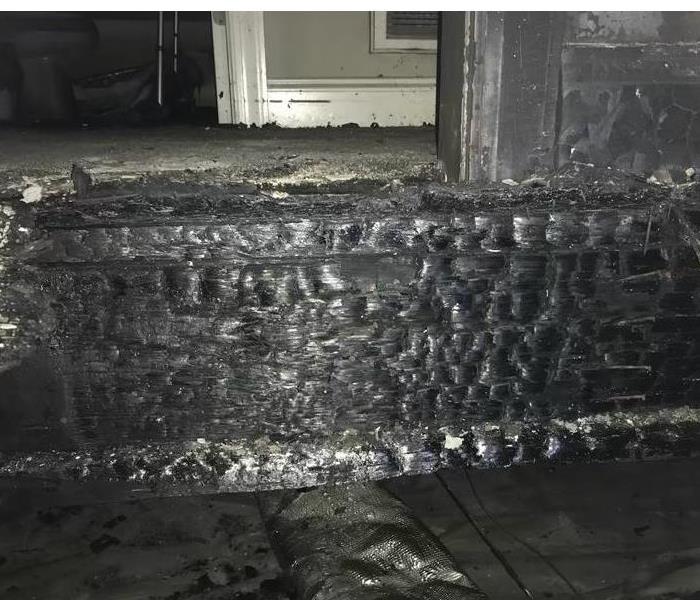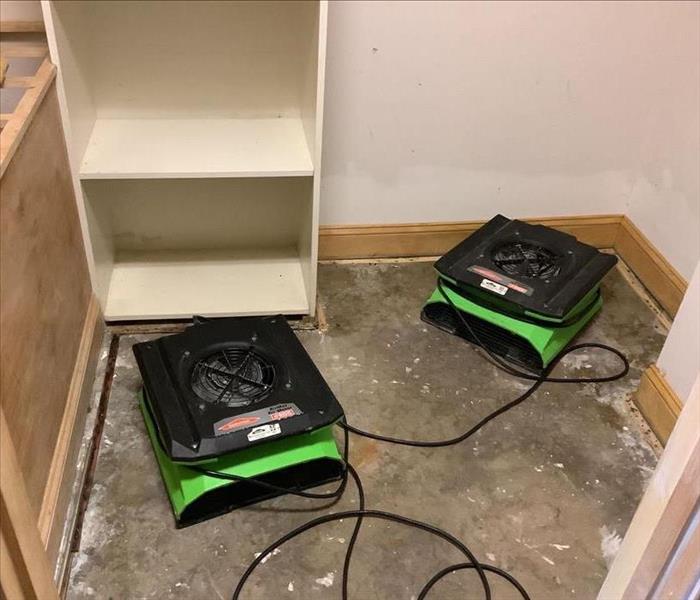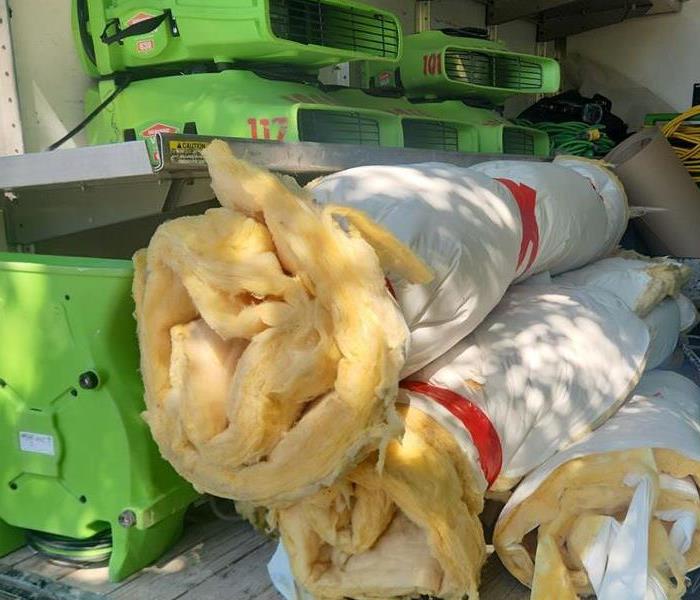Archived Mold Remediation Blog Posts
The Role of Mold in Indoor Odor Problems: Identifying and Eliminating the Source
11/14/2024 (Permalink)
Mold is often a hidden issue in homes and businesses, thriving in damp or poorly ventilated areas. While its presence may not always be immediately visible, one of the most noticeable signs of mold is the unpleasant odor it produces. Mold-related odors can significantly impact the comfort and atmosphere of indoor spaces, and understanding the source of these odors is the first step to resolving the problem.
In this blog, we’ll explore the role of mold in indoor odor problems, how mold odors develop, and why SERVPRO® is your professional mold remediation services that are essential in addressing the issue.
How Mold Causes Odor Problems
Mold itself is a type of fungus that grows in moist environments. As mold colonies expand, they release microbial volatile organic compounds (MVOCs) into the air. These compounds are responsible for the musty, earthy odor commonly associated with mold. The longer mold is allowed to grow unchecked, the stronger and more pervasive the smell becomes.
The odor associated with mold can be caused by a number of factors:
- Decomposition: Mold feeds on organic materials such as wood, paper, and drywall. As mold breaks down these materials, it releases gases, contributing to the musty smell.
- Moisture: Mold thrives in damp conditions, and the combination of moisture and microbial activity leads to the release of foul-smelling compounds.
- Stagnant Air: Poor ventilation can trap mold spores and their associated odors inside a building, making the smell even more noticeable.
Common Areas Where Mold-Related Odors Develop
Mold can grow in a variety of areas, and the associated odors can spread quickly through a home or commercial space. Here are some of the most common places where mold-related smells may develop:
- Basements and Crawl Spaces: These areas tend to be dark and damp, making them prime spots for mold growth. Musty odors in basements are often a telltale sign of mold.
- Bathrooms: Bathrooms are another area prone to mold due to constant exposure to moisture. Mold can easily grow in tiles, grout, and around plumbing fixtures, causing a lingering odor.
- Kitchens: Leaky sinks, appliances, and hidden moisture behind cabinets can lead to mold growth in kitchens. Even small patches of mold can cause strong odors in enclosed spaces.
- Air Ducts: Mold can grow inside HVAC systems and air ducts, spreading odors throughout the building when the system is running. This can make it difficult to pinpoint the exact location of the mold.
- Attics: Poor ventilation in attics can cause mold to grow on insulation, wood beams, and rafters. The odors can seep down into living spaces and may be more noticeable after rainfall or high humidity.
- Water-Damaged Areas: Any area that has been exposed to water damage is at risk for mold growth, leading to musty smells if not addressed properly.
Addressing Mold Odors with Professional Remediation
Mold odors aren’t just unpleasant—they can also signal deeper issues within your property. To effectively remove these odors and prevent mold from returning, professional mold remediation is essential. Here’s how SERVPRO can help:
- Thorough Inspection: SERVPRO’s certified technicians begin with a comprehensive inspection of your property to locate any hidden mold growth and identify the source of moisture.
- Mold Containment and Removal: Using advanced containment techniques, SERVPRO ensures that mold spores don’t spread to other areas of your home or business during the remediation process. Specialized equipment, such as HEPA vacuums and air scrubbers, is used to remove mold colonies from affected areas.
- Odor Removal: SERVPRO utilizes specialized deodorization techniques to eliminate persistent mold odors. This includes the use of air filtration devices and cleaning solutions designed to neutralize the odor-causing compounds produced by mold.
- Moisture Control: SERVPRO addresses the underlying moisture problem to prevent mold from returning. This may involve repairing leaks, improving ventilation, or installing dehumidifiers to maintain proper humidity levels.
- Post-Remediation Restoration: If mold has caused damage to your property, SERVPRO’s restoration services can help repair or replace affected materials, ensuring your home or business is fully restored.
Mold can significantly impact the atmosphere of your home or business by producing strong, persistent odors. These odors often indicate the presence of mold and should not be ignored. Professional mold remediation, like the services offered by SERVPRO, is the most effective way to eliminate mold-related odors and prevent the mold from returning.
If you’re dealing with unpleasant odors in your home or commercial property, contact SERVPRO of Harnett County West for a thorough mold inspection and remediation plan. With SERVPRO’s expertise, you can restore the fresh, clean air quality of your space and ensure that mold no longer poses a problem.
How Mold Can Develop After a House Fire
7/17/2024 (Permalink)
 While a house fire is challenging, preventing mold growth is an essential part of the recovery process.
While a house fire is challenging, preventing mold growth is an essential part of the recovery process.
Going through a house fire is incredibly stressful, and the first priority is always to put out the fire and make sure the house is safe. But once the fire is out, there’s a new problem that might arise: mold. It’s not usually the first thing you’d worry about after a fire, but it’s important to know how mold can begin to grow and spread throughout your home.
The Connection Between Fire and Mold
The process of extinguishing a fire typically involves large amounts of water, whether from fire hoses or sprinkler systems. This necessary step leaves behind an excessive amount of moisture. Since mold spores are naturally present in the air, they only require moisture and organic material to start growing. The conditions post-fire are often prime for mold growth to begin.
Why Mold Growth After a Fire Is a Concern
Mold can cause significant damage to the structure of your home. It has the potential to degrade various materials like wood, drywall, and carpeting, compromising both the strength and integrity of these structures. This makes addressing mold quickly an important step in the post-fire restoration process.
Immediate Steps to Prevent Mold Growth
- Water Extraction: Quickly removing standing water is crucial. Using industrial-strength fans, dehumidifiers, and water pumps can help dry out the affected areas effectively.
- Salvage and Discard: It's important to remove items that are heavily water-damaged and unlikely to dry sufficiently. Materials such as carpets, rugs, and upholstered furniture should be addressed immediately to avoid becoming breeding grounds for mold.
- Increase Airflow: Increasing airflow by opening windows and doors facilitates faster drying and reduces moisture levels.
- Inspect and Clean: Areas affected by soot and smoke should be cleaned thoroughly. Soot can retain moisture, which may encourage mold growth if not addressed.
Professional Mold Remediation
In the aftermath of a fire, engaging professional mold remediation services can be highly beneficial. These experts use advanced tools and techniques to ensure that your home is thoroughly dried and safeguarded against future mold issues. Remediation services typically include:
- A detailed evaluation to identify all areas at risk.
- The use of professional-grade drying equipment and HEPA vacuums.
- Application of antimicrobials to discourage mold growth from the outset.
- Necessary repairs and restoration to structures damaged by water.
Long-Term Mold Prevention
After addressing immediate mold concerns, implementing long-term strategies to prevent recurrence is essential:
- Use dehumidifiers to keep indoor humidity levels below 50%.
- Check your home regularly for signs of moisture, especially in areas prone to dampness like basements and attics.
- Ensure good ventilation, particularly in areas like kitchens and bathrooms, to manage moisture effectively.
While a house fire is challenging, preventing mold growth is an essential part of the recovery process. Taking swift and effective measures can significantly reduce the likelihood of mold development and help maintain the structural integrity of your home. Professional remediation services are invaluable in ensuring a thorough and effective restoration, keeping your home secure and well-maintained. For further guidance or assistance with mold prevention after a fire, don’t hesitate and reach out to our SERVPRO of Harnett County West team today!
Mold in Insulation: What are the Causes and How to Remediate
3/13/2024 (Permalink)
 Mold growth in insulation can cause severe damage to the structure and affect indoor air quality.
Mold growth in insulation can cause severe damage to the structure and affect indoor air quality.
Mold can grow in various areas of a building. One of the places where mold can thrive that is often overlooked is in insulation. Mold growth in insulation can cause severe damage to the structure and affect indoor air quality. In this blog, we will explore how mold shows up in insulation, the causes of mold growth, and the ways to remediate mold in insulation.
How Mold Shows Up in Insulation
Insulation is a breeding ground for mold because of the material's porous nature. The insulation’s fibers provide an ideal place for mold spores to settle and propagate. Over time, mold growth can cause severe damage to the insulation and spread to other areas of the building.
Mold damage in insulation can be hard to detect at first glance, but the signs of a problem are usually visible. These can include:
- Discoloration: Insulation that appears darker than usual can be a sign of mold growth.
- Odor: A musty odor that lingers in a building can indicate the presence of mold in the insulation.
- Water Damage: Insulation is often damaged by water, causing mold to grow in the affected areas.
Causes of Mold Growth in Insulation
Mold growth in insulation can happen due to various factors. Some of the most common causes include:
- Water Damage: Water leaks or excess moisture can seep into insulation and create a damp environment for mold to grow.
- Poor Ventilation: Inadequate ventilation in the building can cause moisture to accumulate in the insulation, leading to mold growth.
- Humidity: High humidity levels can cause insulation to retain moisture, which increases the likelihood of mold growth.
- Contaminated Materials: Insulation material can carry mold spores, which can result in mold growth in the insulation.
Remediation Techniques for Mold in Insulation
Remediating mold in insulation requires a thorough process. Here are the steps for remediation:
- Assessment: The first step is to assess the scope of the mold damage and identify the affected areas. This assessment will guide the remediation process.
- Remove Damaged Insulation: Any insulation that is mold-damaged should be removed and properly disposed of to prevent further mold growth.
- Ventilation and Dehumidification: After removing the damaged insulation, the space should be ventilated and treated to reduce the humidity levels to combat future mold growth.
- Sanitation: The affected area should be thoroughly cleaned using suitable antimicrobial products to eliminate any mold spores and prevent any further growth.
- Replace Insulation: Once the area is clean and free of mold, insulation should be replaced. New insulation should be installed to ensure that the area remains mold-free in the future.
Preventing Future Mold Growth in Insulation
Prevention is always the best way to avoid mold growth in insulation. Here are some tips to prevent future mold growth:
- Address Moisture and Water Issues: Addressing moisture and water issues is the most crucial step in preventing mold growth in insulation. Regular inspections, identifying any signs of water damage, and treating them immediately can prevent mold growth.
- Improved Ventilation: Proper ventilation of the areas where insulation is located can help reduce humidity levels, reducing the risk of mold growth.
- Insulation Materials: Choosing insulation materials that are resistant to mold growth can also reduce the risk of future problems.
- Regular Inspection: Regular inspection of insulation at least twice a year can detect any signs of mold growth or damage and preventative measures can be taken.
Prevent Mold in Your Insulation
Mold growth in insulation can cause severe damage to a building's structure and indoor environment. Addressing moisture and water issues, improving ventilation and air circulation, regular inspection, and removal of any damaged insulation can prevent mold growth. Remembering prevention is key, addressing issues as soon as they arise can save time and money for property owners. Professional mold remediation services can be instrumental in identifying potential problems and providing solutions to prevent mold growth in insulation.
Mold Prevention Tips for Raleigh, NC Homeowners
5/10/2023 (Permalink)
As a homeowner in the Raleigh area, you may be concerned about the potential for mold growth in your home. Mold can cause serious problems and can be difficult and expensive to remove once it takes hold. The good news is that there are several things you can do to prevent mold growth in your home. In this blog, we'll discuss some mold prevention tips that will help you keep your home mold-free.
Control humidity levels
Mold thrives in moist environments, so it's important to control the humidity levels in your home. You can do this by using a dehumidifier or air conditioner to keep the air dry. Ideally, you want to keep the humidity levels below 60 percent. You can also use exhaust fans in the kitchen and bathroom to remove moisture from the air.
Fix leaks promptly
Leaking pipes and faucets can create the perfect environment for mold growth. If you notice any leaks in your home, it's important to fix them promptly. This will not only prevent mold growth but will also save you money on your water bill.
Improve ventilation
Good ventilation is essential for preventing mold growth. Make sure your home is properly ventilated by opening windows and doors and using exhaust fans. You can also consider installing a ventilation system in your home.
Use mold-resistant products
When building or renovating your home, consider using mold-resistant products such as drywall, insulation, and paint. These products are specially designed to resist mold growth and can help prevent mold from taking hold in your home.
Clean and dry water-damaged areas
If your home experiences water damage, it's important to clean and dry the affected area as soon as possible. This will prevent mold from growing in a damp environment. If the water damage is extensive, you may need to hire a professional restoration company to clean up the area.
Keep your home clean
Regular cleaning can help prevent mold growth by removing dirt and dust that can provide a breeding ground for mold. Make sure to clean all surfaces in your home regularly, including walls, floors, and ceilings. Pay special attention to areas that are prone to moisture such as bathrooms, kitchens, and basements.
Monitor indoor humidity levels
Finally, it's important to monitor the humidity levels in your home regularly. You can do this by using a hygrometer, which measures the amount of moisture in the air. If you notice that the humidity levels are consistently high, you may need to take additional steps to control the moisture in your home.
In conclusion, preventing mold growth in your home is essential for the safety of your property and family. By following these mold prevention tips, you can keep your home mold-free and enjoy a safe living environment. If you do experience mold growth in your home, it's important to address the problem promptly to prevent it from spreading and causing further damage.

 24/7 Emergency Service
24/7 Emergency Service


